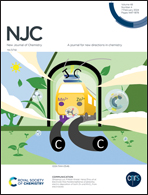Ingenious microenvironment regulation of a metal–organic framework (MOF) nanoreactor for electrochemical detection of chlorogenic acid†
Abstract
The ingenious microenvironment regulation of a metal–organic framework (MOF) is vital for the advancement of electrochemical sensing applications. Herein, the PcFe@ZIF-8 (PcFe, iron phthalocyanine and ZIF-8, zeolitic imidazolate framework-8) hybrid material was constructed by an in situ impregnation strategy. Then, the hollow MOF nanocomposite, Au/PcFe@HZIF-8 (Au, gold and HZIF-8, hollow ZIF-8), was successfully fabricated via the Kirkendall effect without additional templates/etchants. Next, the Au/PcFe@HZIF-8 electroanalysis platform was assembled for sensitive detection of chlorogenic acid (CGA). Abundant active sites provided by the ultra-small sized Au NPs, redox characteristics of PcFe and quicker mass transfer exhibited by hollow MOF cavities were the key factors responsible for ingenious microenvironment regulation. From electrochemical performance evaluation, it was found that the response interval was from 0.03 to 500 μmol L−1 and the detection limit was 0.01 μmol L−1 (S/N = 3). In addition, Au/PcFe@HZIF-8/GCE displayed superior selectivity and stability, which allowed the sensor to achieve satisfactory results in actual sample detection as well. Furthermore, several statistical analyses (F-test and t-test) were applied to ensure the precision of practical sample detection. This novel strategy for the construction of hollow MOFs and ingenious microenvironment regulation will unveil a different path for the electrochemical applications of porous hybrid nanomaterials.



 Please wait while we load your content...
Please wait while we load your content...